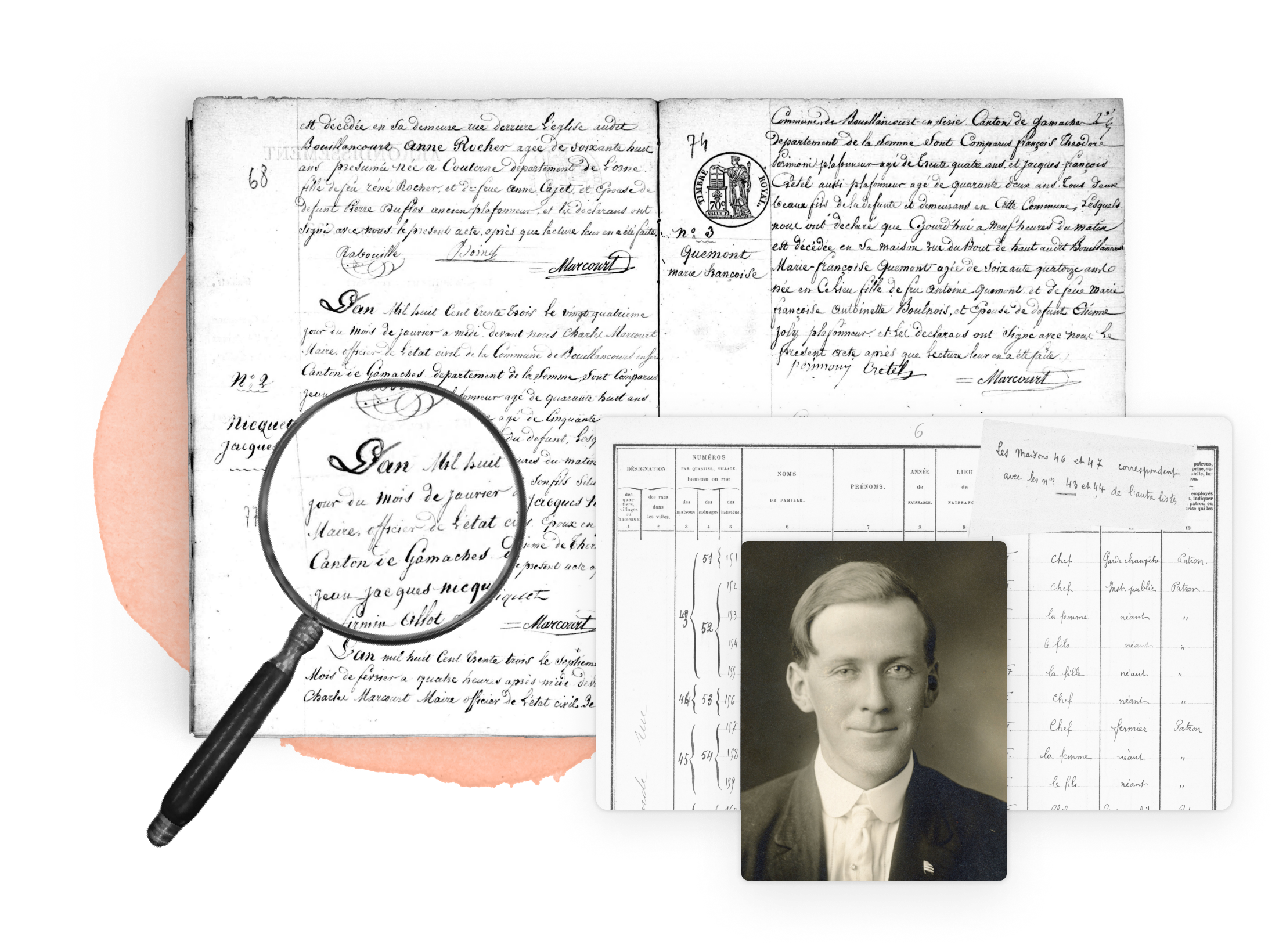
Ellis Island was the main processing center for immigrants arriving through the port of New York City from 1892 until 1954, and was the busiest immigrant inspection and processing station in the United States of America.[1] The records generated by the US federal government documenting the arrival process serve as valuable resources for genealogists and family historians. There are over 65 million documents available to help you learn more about your immigrant ancestors.
Research your ancestors on MyHeritage
History of Ellis Island

On April 11, 1890, the U.S. federal government ordered the naval magazine at Ellis Island be torn down, in order to make way for the country's first federal immigration station at the site,[2] replacing the facilities at Castle Clinton.
It's been rumored that immigrants were unwillingly forced to take new names upon arrival to Ellis Island, though there are no historical records of this. Rather, immigration officials used the names from the manifests of steamship companies, which served as the only immigration records for those entering the United States. Records show that immigration officials often actually corrected mistakes in immigrants' names, since inspectors spoke on average three languages, and each worker was usually assigned to process immigrants who spoke the same languages.[3][4] Many immigrant families Americanized their surnames afterward in a voluntary manner, either immediately following the immigration process or gradually as part of their assimilation process into American culture.[4]
Ellis Island closed on November 12, 1954 and since its opening on January 1, 1892, after processing more than 12 million immigrant arrivals. The last detainee, a Norwegian merchant seaman named Arne Peterssen, was released and the U.S. government officially closed Ellis Island.
The Immigrant Quota Act of 1921 and the National Origins Act of 1924 severely restricted immigration and translated to much lower numbers of immigrants being processed through Ellis Island. The main building at Ellis Island is now the location of the Ellis Island National Museum of Immigration run by the United States National Park Service. If you think your ancestor arrived in New York City between 1892 and 1954, make sure you search the available records and resources for the Ellis Island Immigration Center.
What’s included in Ellis Island immigration records
Ellis Island immigration records are a valuable resource for genealogy research. Ellis Island records include the following information:
- Name of the immigrant (including their given name, surname, and any aliases)
- Date of arrival
- Name of the ship
- Port of arrival
- Age
- Sex/Gender
- Marital status
- Occupation
- Nationality
- Place of birth
- Last place of residence
- Name and address of the nearest relative in the passenger's home country
- Final destination
- Whether the passenger had been to the United States before
- Physical description (height, hair, and eye color)
- Literacy level (if they could read or write)
A massive fire broke out at Ellis Island on June 15, 1897 destroying all immigration records from 1855 to 1897. The Castle Garden records were stored at Ellis Island after it was decommissioned in 1892.
MyHeritage: Ellis Island and Other New York Passenger Lists, 1820-1957
The Ellis Island and Other New York Passenger Lists, 1820-1957 record collection at MyHeritage contains over 113 million indexed records that can be searched by:
- First Name
- Last Name
- Birth Year
- Birth Place
- Departure/Arrival Date and Place
- Destination Place
- Ship name
- Father
- Mother
- Spouse
- Gender

During the 19th and 20th centuries, millions of immigrants came to the United States. This collection contains millions of records of individuals arriving at the port of New York between 1820 and 1957. This includes individuals who arrived at three well-known immigrant processing stations: Castle Garden (1855-1890), the Barge Office (1890-1892), and Ellis Island (1892-1957).
Early passenger lists were single page manifests and recorded minimal information about passengers. Over time forms were standardized and additional questions were added. Depending on the year, information recorded about a passenger may include name, age, gender, occupation, destination, and information regarding place of origin—e.g. native country, citizenship status, race, nationality, birthplace, or last residence. By 1907 passenger manifests contained 29 columns and were two-pages wide with left and right sides. Many of the passenger manifests span two pages, and a common omission for genealogists has been to locate the first page and miss the existence of the second. MyHeritage has solved this problem for the first time by stitching the double pages into single document images, ensuring that important information will not be missed.
Two questions that were included on the manifest beginning in 1907 were: 1) name and address of nearest friend or relative in the country whence the alien came; and 2) whether going to join a relative or friend, and if so, what relative or friend, and his name complete address. MyHeritage has indexed the names and relationships of the individuals referenced in these two additional questions, making MyHeritage the only place where these additional names are searchable.
On June 2018, more records were added to this collection, primarily from crew lists, lists of detained alien passengers, U.S. citizen lists, and lists of aliens held for special inquiry. Records in this collection come from National Archives (NARA) microfilm collections M237 (Passenger Lists of Vessels Arriving at New York, New York, 1820-1897) and T715 (Passenger and Crew Lists of Vessels Arriving at New York, New York, 1897-1957).
Tips and tricks for researching Ellis Island immigration records
- Start by gathering as much information as you can about your ancestor, such as their name, date of arrival, and ship of arrival.
- Use the search fields on the Ellis Island and Other New York Passenger Lists, 1820-1957 database at MyHeritage to search for your ancestor.
- Remember that the time period for Ellis Island records is 1892-1954. Check Castle Garden records for New York immigrant arrivals prior to 1892.
- If you don't find your ancestor's name, you can try searching by other criteria, such as the ship of arrival or the port of entry.
- Once you find your ancestor's record, be sure to read all of the information carefully. The records may include additional information, such as the names of other family members who were traveling with the immigrant.
- Check US Census records for an ancestor’s year of arrival. In addition, check other records such as obituaries, church or synagogue records, and other records that might list a birthplace.
- Don’t forget naturalization records. Records such as Declaration of Intent and Citizenship will often list the birth place of your ancestor.
- Use the F.A.N. club methodology (“friends, associates, and neighbors”) and look for others who arrived from the same location or birth place for additional clues.
- Leverage the power of name variations since spelling of names was often inconsistent during the 19th century.
- Don’t assume that your immigrant ancestor arrived in New York City. Check other ports such as Boston and Philadelphia.
See also
Explore more about Ellis Island immigration records
- Ellis Island and Other New York Passenger Lists, 1820-1957 record collection on MyHeritage
- Coming to America: The Legacy of Castle Garden and Ellis Island on the MyHeritage Blog
- Access to Archival Databases: Immigration - National Archives and Records Administration
- Was Your Surname Really Changed at Ellis Island? on the MyHeritage Knowledge Base
- Ellis Island - United States National Park Service
- A Guide to Interpreting Passenger List Annotations - JewishGen
- Passenger Search - The Statue of Liberty―Ellis Island Foundation, Inc.
- The 1890 Census Fires and Other Burned Genealogy Records - Family Tree Magazine
- Which One-Step Ellis Island Search Form Should I Use? - One Step Webpages by Steve Morse
References
- ↑ Ellis Island. The Statue of Liberty—Ellis Island Foundation, Inc.
- ↑ Statue of Liberty National Monument (N.M.) and Ellis Island, Ellis Island Development Concept Plan: Environmental Impact Statement
- ↑ Why Your Family Name Was Not Changed at Ellis Island (and One That Was). New York Public Library
- ↑ 4.0 4.1 Ault, Alicia. Did Ellis Island Officials Really Change the Names of Immigrants?. Smithsonian Magazine


